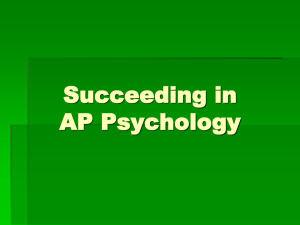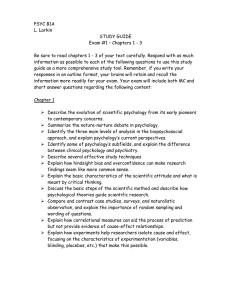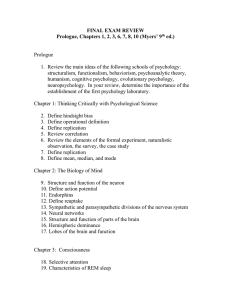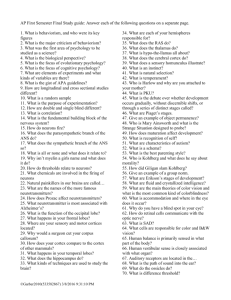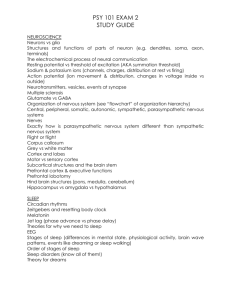StudyGuideExam1Spring12
advertisement
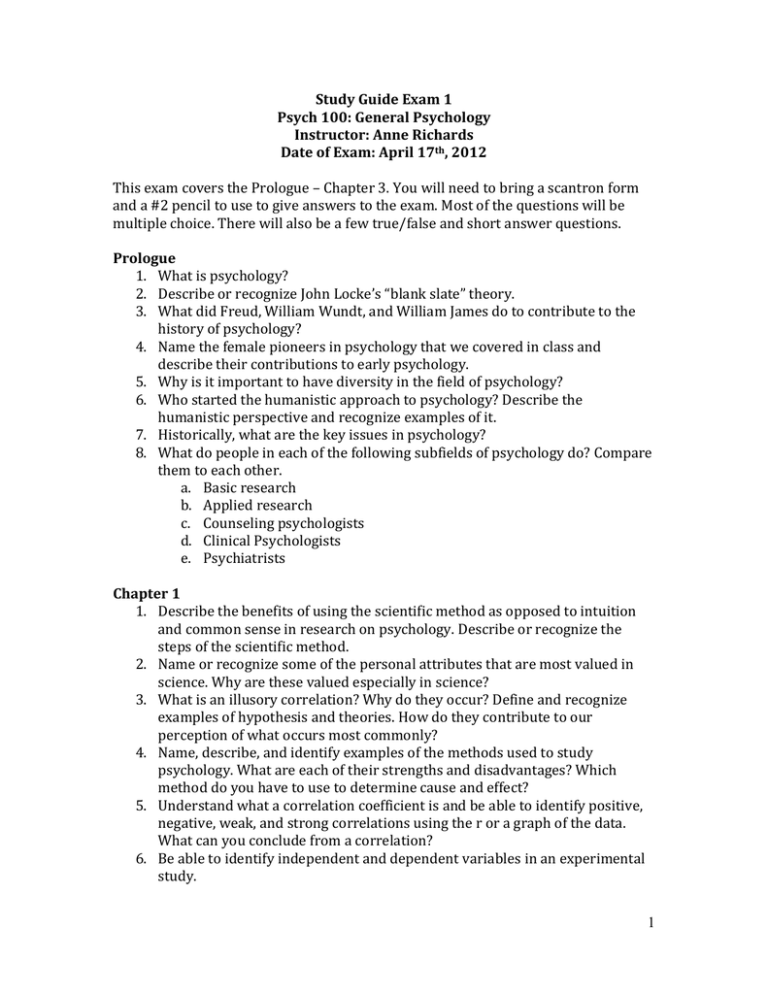
Study Guide Exam 1 Psych 100: General Psychology Instructor: Anne Richards Date of Exam: April 17th, 2012 This exam covers the Prologue – Chapter 3. You will need to bring a scantron form and a #2 pencil to use to give answers to the exam. Most of the questions will be multiple choice. There will also be a few true/false and short answer questions. Prologue 1. What is psychology? 2. Describe or recognize John Locke’s “blank slate” theory. 3. What did Freud, William Wundt, and William James do to contribute to the history of psychology? 4. Name the female pioneers in psychology that we covered in class and describe their contributions to early psychology. 5. Why is it important to have diversity in the field of psychology? 6. Who started the humanistic approach to psychology? Describe the humanistic perspective and recognize examples of it. 7. Historically, what are the key issues in psychology? 8. What do people in each of the following subfields of psychology do? Compare them to each other. a. Basic research b. Applied research c. Counseling psychologists d. Clinical Psychologists e. Psychiatrists Chapter 1 1. Describe the benefits of using the scientific method as opposed to intuition and common sense in research on psychology. Describe or recognize the steps of the scientific method. 2. Name or recognize some of the personal attributes that are most valued in science. Why are these valued especially in science? 3. What is an illusory correlation? Why do they occur? Define and recognize examples of hypothesis and theories. How do they contribute to our perception of what occurs most commonly? 4. Name, describe, and identify examples of the methods used to study psychology. What are each of their strengths and disadvantages? Which method do you have to use to determine cause and effect? 5. Understand what a correlation coefficient is and be able to identify positive, negative, weak, and strong correlations using the r or a graph of the data. What can you conclude from a correlation? 6. Be able to identify independent and dependent variables in an experimental study. 1 7. Why isn’t the mean (average) always the best way to describe data? When would the mean be misleading? What other measures of central tendency can be used? 8. Why is it important to know the variability within a data set? Name and define two measures of variability. 9. What are the factors that would increase the chances that a difference between groups found in a study would be considered reliable and significant? 10. Describe the ethical rules for using human subjects in experiments. Chapter 2 1. What is a neuron? What are their functions? Be able to label the 4 parts of a neuron. 2. How does a message travel from one end of a neuron to the other? 3. How does a message travel from one neuron to another? 4. Define the term Action Potential. 5. What is reuptake and what is it’s function? 6. Describe the general functions of the following neurotransmitters: glutamate, GABA, serotonin, dopamine, norepinephrine 7. How are hormones regulated? Which part of the brain regulates them? Describe the main effects of testosterone, including the correlates of testosterone levels. 8. Describe or recognize the methods that can be used to study the brain which were mentioned in class and in the textbook. 9. What are the functions of the “old brain”? Where is the “old brain” located? 10. Know the following terms: Central Nervous System, Peripheral Nervous System, Autonomic Nervous System, Somatic Nervous System, Parasympathetic nervous system, and Sympathetic Nervous System. 11. What are the main functions of the cerebral cortex? Be able to label the 4 lobes of the cerebral cortex. 12. Define neuroplasticity. Provide or recognize examples of it. Are there any areas of the brain where new neurons continue to form throughout life? If so, where? 13. Compare the organization and function of the left versus the right side of the cerebral cortex. What types of studies are used to study the 2 sides of the brain separately? Chapter 3 1. How does attention relate to consciousness? 2. Define selective attention and recognize examples of it. Describe inattention blindness, change blindness, and the cocktail phenomenon? 3. What are some of the things that can affect our circadian rhythm? 4. How is sleep measured? 5. Name and describe the stages of sleep. Which stage is the deepest type of sleep? 2 6. How long is the average sleep cycle? List the sequence that the stages of sleep usually occur in within one sleep cycle. How does the sleep cycle change when someone is sleep deprived or when someone is deprived of REM sleep. 7. How can you tell if someone is in REM sleep? What happens during REM sleep? 8. List or recognize the symptoms of sleep deprivation. 9. Describe or recognize three theories for why we and other mammals need sleep. 10. Describe or recognize three theories about why we dream. 11. Know the names of the sleep disorders listed in the book and describe or recognize the symptoms associated with each of them. 12. Name the effective methods for improving insomnia. 3

